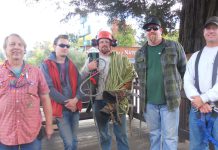Editor’s note: This is the full version of a commentary published in the Press-Banner on May 17, 2013.
My quiet reverie was interrupted by the phone jangling. I have the habit of letting the phone go to the recorder so that I do not get stuck with a telemarketer. The message recorder just began to sound out my neighbor’s concerned voice as I rushed to the phone before she could hang up. I did not quite catch who was trying to dig a hole in her newly paved driveway. We had only paid the huge bill two days ago for repaving a portion of our private road and I could not believe that anyone would do such mischief. Had I heard correctly?
“I am late for work, so I can’t talk but call Dana or Alison for more information. Alison caught them digging in her road also.” Shocked by this revelation, I thanked my neighbor and let her leave for work. I immediately called Alison to find out what in the world was going on. She explained that she was on her way to New Leaf Market when she discovered that someone was digging a hole in her private road. He told her that he was an employee of San Lorenzo Water District(SLVWD) and that he was taking soil samples. It really disturbed her when he claimed “that she could not stop him.” She also discovered that SLVWD owned a small piece of property next to her road where they used to keep a small water tank. Only a pipe and water spigot remain as a small hint of the tank’s previous existence. Alison knew that there was an easement that ran with her road for utility providers, but she had never met any who deliberately perpetrated damage to her road or who were personally rude.
Like Alison, I felt immediately angry and helpless that people like that man who was digging holes in our roads and driveways felt that it was alright for him to do so especially without explaining who he represented or why he was there. Had Alison not caught him in the act of digging, she may not have discovered that SLVWD planned to build a pumping station on that small plot of land where the old water tank used to be located. “They want to use the Proposition 50 grant money for the Intertie system that was voted in a few years ago and this is where they want to pump water over this mountain into Lompico,” is what she told me.
I vaguely remembered the Intertie system, but it had been a while since that had been on a ballot and my memory had become fuzzy. All I could immediately focus on was that my quiet neighborhood in a redwood forest was being invaded by someone who wants to upset the nature of our bucolic environment. We were told that we could not stop them, is this really true that this could happen? We had all invested heavily in our properties because we choose to live in a quiet, redwood forest away from traffic and anything akin to city hustle. We guard our redwood trees, deer and other wild critters. It is quiet. We hear the wild turkeys approach when they pay us a visit. In the summer time, when we sit on the deck, we can hear the train whistle from Roaring Camp. These are all charming sounds that we have come to love, but they do not include the sound of a pump station for that is one sound that we never want to hear.
Several of us from the community began attending the SLVWD Board Meetings to learn more about the Proposition 50 Grant and the Intertie system that is expected to cost $12,850,000.00 of which $6,847432.00 would be funded by the grant leaving only $4,800,000. for SLVWD while the remainder is shared by the other water purveyors. The purpose of the Intertie is to protect our valley water system and to provide a means of shifting water from one community to another should an emergency occur which could endanger the water supply of any one area. It is a basically a good plan. It is supposed to only be used in times of emergency and that is what we were told we should expect by SLVWD. Specifically, the pump, which would be located next to the property that my husband and I own, would only be run once per month for a couple of hours for maintenance purposes if there was no emergency. Initially that seemed reasonable since it would help the Lompico people. At least, that is what the General Manager of SLVWD told us would happen.
We began going to the SLVWD Board meetings in the beginning of January, 2013. They occur twice monthly. Then, public meetings between the Lompico Valley Water District and SLVWD began to be scheduled to discuss a possible consolidation of the two water districts. We attended these meetings as well. Soon, we discovered that the Lompico water system was in severe disrepair and that the District’s finances were in a similar state. They had withdrawn from the State retirement system, PERS, and owed approximately $914,000.00, for which they were unable to pay and interest was accruing. Should the two districts merge, SLVWD would have to accept all of Lompico’s debt and the cost of bringing their water infrastructure up to standard. Where would they find the funds to do this?
The people in my community pondered these issues. We knew that we had a potential problem when we heard the District Manager explain to the Board of Directors that in time they could apply to have the “emergency only use of the Inter-tie 5” converted to operational use. We realized that if they actually built the pump site in our neighborhood, that in the near future it could go into full time operation to pump water over our mountain into Lompico.
We became even more concerning when we read the SLVWD’s Notice of Intent to adopt a Mitigated Negative Declaration(MND) about the environmental impact of the proposed Intertie system. We did not know what a “mitigated negative declaration” meant until we researched the process. It is a legal method that a developer can use to overcome legal requirements imposed by law for protecting natural environments from certain types of development. Simply put, it consists of discovering what could be endangered in an environment and then identifying how a developer would mitigate the danger. Should the public not be able to provide acceptable factual objections within the specified review period, then the developer may legally proceed without performing the more rigorous procedures that a formal Environmental Impact Report(EIR) would require.
When we read the approximately 1 inch thick mitigated negative declaration document, we were in overload with respect to the legal issues to which it addressed. We began a research process that required intense effort on the part of everyone in the neighborhood. We had thirty days to work our way through the document and come to an understanding of the issues so that we could make a timely response. Since my husband is a registered engineer, he was tasked with reviewing the engineering claims which were made in the document. As it turned out, he identified several errors, omissions and missing information of which would be necessary to compute facts to verify some of the claims made in the document. There were also several instances that we found where the document was internally inconsistent. It did not present information such that we felt that we could trust it particularly for computing sound levels of a pumping station. They misrepresented the distance between the proposed pump station and the “nearest sensitive receptor” by almost 50%. Oh, by the way, a “sensitive receptor” is a human being.
One of the glaring errors in the document, that did not require an engineer’s opinion, was that it presented plans of how they would detour traffic and make sure that we had one of the two lanes available for passing during the time that they would be tearing up our road. They failed to state that our private, mountain road is only one lane and dead ends so there is no detour possible. Their claim was a complete misrepresentation of the facts in that discussion which also conflicted with statements made in other parts of the document. They had also claimed verbally that they could complete tearing up our private road and replacing the existing pipe with eight inch pipe in a period of about three in a half weeks whereas the document promised about 6 months to complete the job. Our private, one lane road, is without adequate passing room even when there is no construction crew with large equipment tearing up the road. There is no place in our neighborhood to park either their equipment or our cars if we cannot access our driveways. There is nowhere near by where we could park that would not require transportation to and from that unidentified area. Most of us in our neighborhood do not have ‘8 to 5′ jobs and we must come and go at various times during the day. We find it very difficult to envision the mess that our road would be and the difficulty of accessing our own homes and being able to even get out of the neighborhood. Even more frightening is the potential for the people in our neighborhood who could need emergency medical treatment. Emergency vehicles would have great difficulty getting through a construction zone on our road to give life support to anyone who would need such care. We have three people who might need such care.
Those are some of the problems that we were able to identify from our understanding of the report which was issued by SLVWD. There were others which did require a registered engineer to identify. Fortunately, we were able to submit our objections within the time period that was permitted us. We don’t know yet what the response to our comments will be. However, we know that they could alternately lay their pipe down Lompico road where they would have a two lane road and they would not be permanently disturbing a neighborhood just so that they could pump water over our mountain to Lompico. If it actually was meant to be used only for emergency purposes, it would not be so bad. However, we have heard the discussion during SLVWD Board meetings that after a short time they can apply to have the ’emergency only’ status reclassified to permanent operations. Should SLVWD and the Lompico Valley Water District merge, then the Intertie-5 pump could be pumping on a full time basis.
We are still attending Board meetings and Lompico Liaison meetings. One of the latest issues that we heard about is respecting the Olympia Mutual Consolidation Project. The annexation of the territory is underway. At the last SLVWD Board Meeting, the Board of the Olympia Mutual Water Company were shocked to discover that the projected costs per family in that community was increased from about $10,000 to approximately $20,000 as a result of the annexation. The total cost for the project is stated as $1,641,810.00 of which SLVWD will assume $767,750.00. We also learned about the Campus Project which will house the new administrative offices for SLVWD, which will cost a bit more than $5,000,000. We also learned about the proposed increases in water rates. They will rise 65% over the next five years. When we leave the Board meetings, we hear other people discussing the issues. If I could describe the conversations in terms of color instead of tone, I would describe them as conversations painted with vibrant red and orange tones. As an artist, I use these colors to represent anger and the feelings that express violation. I cannot say that they feel violated, but I do feel that way when I think about what SLVWD wants to do to our community.
The last time that I spoke with Rick Harrington, who is the board chairman of the Lompico Water District, we discussed our mutual fear for the potential of a forest fire that could consume both of our valleys. We agreed that in the summer time, they might not have enough water to fight such a fire without the Intertie-5 being in place. One thing that did not enter our thoughts at that time was the fact that the plan is to lay HDPE pipe over the mountain that separates our two valleys. High Density Polyethylene Pipe(HDPE) is light weight, flexible, and easier to install than the rigid version. However “HDPE is susceptible to fire damage, especially at outfall locations. Therefore, fire damage may result due to an adjacent grass fire. (ConnDOT Drainage Manual Guidelines from Culvert Repair, Materials and Structural Design 4.C-1.” This is a problem that the people in our neighborhood did not consider when we analyzed our IS/MND. My fear is to see red and orange flames raging over the ridge between Lompico and Zayante.
I just received an early warning message from Cap Pennell who is the District Emergency Communications officer for the Santa Cruz County Amateur Radio Emergency Services (ARES). Cap’s warning is about an early fire season for our area ( see http://www.readyforwildfire.org/). Cap sent this warning to our local emergency communications groups. I personally support and belong to ARES. I also teach Amateur Radio Licensing classes as well as organize, support and help administer FCC licensing exams. Many of the people who become licensed radio operators are members of CERT and Equine EVAC. We are all sensitive to fire prevention and are involved in various elements of emergency services. Together, we form a strong group who really do not want to see any of our forested or grassy areas raging in the flaming hues of reds and oranges. We have already suffered one small fire near Roaring Camp. That is less than five miles from Zayante and Lompico. Should a fire consume our redwood forest and homes, aided by HDPE between our two valleys, we would all suffer from a violation which cannot be expressed in mere terms of red and orange.












